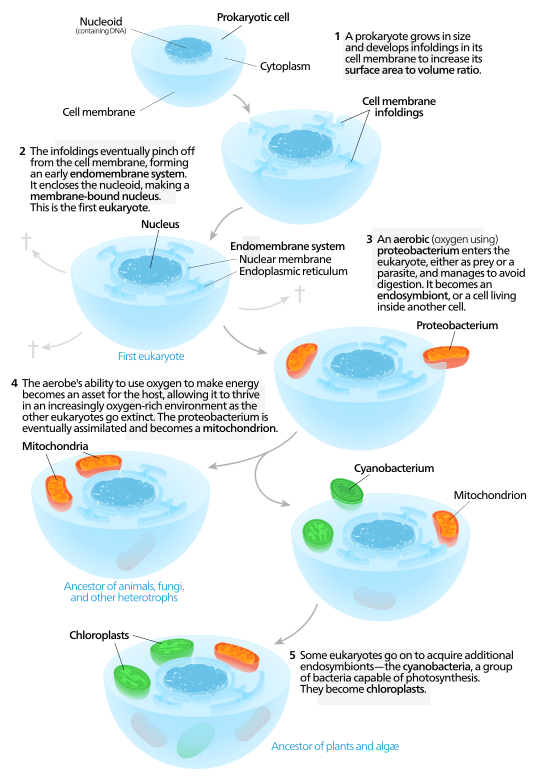Which Statements Are True For Chloroplasts? Select The Three That Apply
7.8: The Endosymbiotic Theory
-
- Last updated
- Save as PDF
- Page ID
- 3220
-

- Professor (Microbiology) at Community College of Baltimore Country (Cantonsville)
Learning Objectives
- Briefly describe what is meant by the endosymbiotic theory.
- Give some evidence supporting the theory that mitochondria and chloroplasts may have arisen from prokaryotic organisms.
It is thought that life arose on earth around four billion years ago. The endosymbiotic theory states that some of the organelles in today's eukaryotic cells were once prokaryotic microbes. In this theory, the first eukaryotic cell was probably an amoeba-like cell that got nutrients by phagocytosis and contained a nucleus that formed when a piece of the cytoplasmic membrane pinched off around the chromosomes. Some of these amoeba-like organisms ingested prokaryotic cells that then survived within the organism and developed a symbiotic relationship. Mitochondria formed when bacteria capable of aerobic respiration were ingested; chloroplasts formed when photosynthetic bacteria were ingested. They eventually lost their cell wall and much of their DNA because they were not of benefit within the host cell. Mitochondria and chloroplasts cannot grow outside their host cell.
Evidence for this is based on the following:
- Chloroplasts are the same size as prokaryotic cells, divide by binary fission, and, like bacteria, have Fts proteins at their division plane. The mitochondria are the same size as prokaryotic cells, divide by binary fission, and the mitochondria of some protists have Fts homologs at their division plane.
- Mitochondria and chloroplasts have their own DNA that is circular, not linear.
- Mitochondria and chloroplasts have their own ribosomes that have 30S and 50S subunits, not 40S and 60S.
- Several more primitive eukaryotic microbes, such as Giardia and Trichomonas have a nuclear membrane but no mitochondria.
Although evidence is less convincing, it is also possible that flagella and cilia may have come from spirochetes.

Example \(\PageIndex{1}\)
- Briefly describe what is meant by the endosymbiotic theory.
- Give three points of evidence supporting the theory that mitochondria and chloroplasts may have arisen from prokaryotic organisms.
Solutions
- The endosymbiotic theory states that some of the organelles in eukaryotic cells were once prokaryotic microbes.
-
- Mitochondria and chloroplasts are the same size as prokaryotic cells and divide by binary fission.
- Mitochondria and chloroplasts have their own DNA which is circular, not linear.
- Mitochondria and chloroplasts have their own ribosomes which have 30S and 50S subunits, not 40S and 60S.
Summary
The endosymbiotic theory states that mitochondria and chlopoplasts in today's eukaryotic cells were once separate prokaryotic microbes.
Contributors and Attributions
-
Dr. Gary Kaiser (COMMUNITY COLLEGE OF BALTIMORE COUNTY, CATONSVILLE CAMPUS)
Which Statements Are True For Chloroplasts? Select The Three That Apply
Source: https://bio.libretexts.org/Bookshelves/Microbiology/Book:_Microbiology_%28Kaiser%29/Unit_4:_Eukaryotic_Microorganisms_and_Viruses/07:_The_Eukaryotic_Cell/7.8:_The_Endosymbiotic_Theory
Posted by: mcleanluelf2001.blogspot.com

0 Response to "Which Statements Are True For Chloroplasts? Select The Three That Apply"
Post a Comment